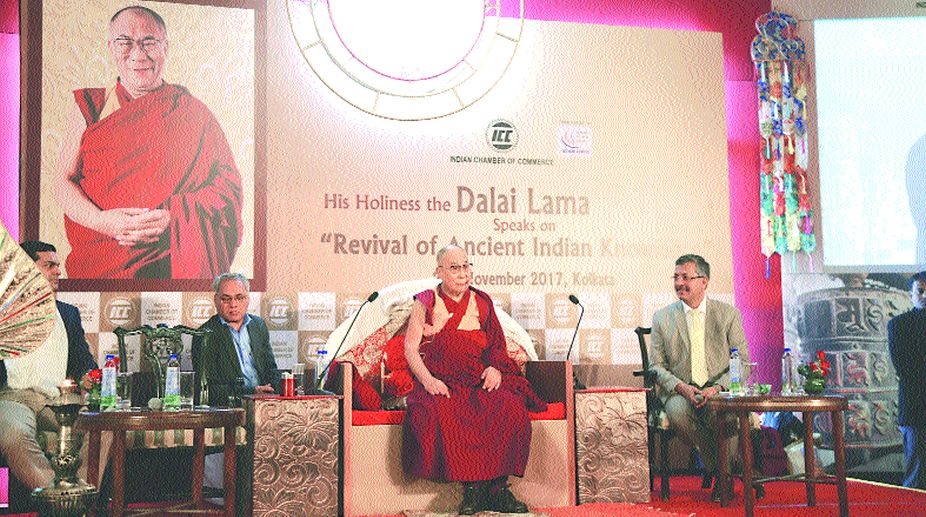The Dalai Lama in Sikkim after 13 yrs
The 14th Dalai Lama arrived in the State Capital of Sikkim today on a three-day visit to Sikkim after a gap of 13 years.

Tibetan spiritual leader Dalai Lama has been an inspiration for many people across the globe. He has been the Dalai Lama for 77 years, working as a harbinger of peace. Peace and love may well be inextricably bound together but the world is torn apart by hostility. Yet, he is of the view that all seven billion human beings are capable of giving love to others. He says, “Man is a social animal but what separates us from other animals is our marvellous brain”.
Speaking at an event organised by the Indian Chamber of Commerce in Kolkata, he spoke on a variety of topics which was essentially a talk on “The Revival of Ancient Indian Knowledge”. President of ICC Shashwat Goenka, ICC Director-General Dr. Rajeev Singh and Chairman of OBEETEE Rudra Chatterjee were present on the occasion. The Dalai Lama began with how this planet is capable of living in harmony but millions of people are in agony citing the example of children suffering from starvation in Yemen. He is of the view that this evil is man’s own creation and man has the ability to overcome these hindrances.
We are surrounded by divisive politics of religion and region. According to him, religion creates division but strongly states, “We need every effort to promote sense of oneness of seven billion human beings”, which can, in turn, stop division on the basis of religion.
Advertisement
Certainly, India is home to a number of religious traditions, starting from Jain and Buddhist philosophy to Judaism and then Islam. He pointed out how India has become home to all major world religions remaining true to its secular nature but sometimes politicians manipulate religion. This may have been a dig at the current religious scenario governing the country.Ironically enough, he says modern India is base out of sound historical culture.
Moving on to Tibet, he clearly made his duty toward preserving Tibetan culture discernible and emphasised on the importance of the Tibetan plateau in this regard. He claimed that the rivers flowing through Tibet are conducive to people living not only in Tibet but also China, Vietnam, Laos, Cambodia, India and Bangladesh. His unwavering dedication toward promoting Tibetan culture was not too much of a daunting task to comprehend.
On “The Revival of Ancient Indian Knowledge”, the Dalai Lama mentioned how Indians were the gurus of Tibetans and discussed about the contribution of major ancient scholars such as Asanga, Buddhapalita, Nagarjuna, Dharmakirti and others. The Dalai Lama eulogised the University of Nalanda and stressed on the importance of quantum physics and psychology in reviving ancient Indian knowledge by acknowledging “ancient Indian psychology is highly developed”.
A UNESCO World Heritage site, Mahavira and Gautam Buddha are said to have delivered lectures in Nalanda – such is the history of education related to Nalanda. The re-establishment of these ancient learning centres especially in southern India has given shelter to over ten thousand monks.
Defining his aim to revive ancient knowledge through education he said, “Education alone should take both responsibilities — development of intelligence and development of warm-heartedness”. India should combine modern education, modern technology and modern economy with inner values is what he believed in. He opines that the world is in an emotional crisis and in this field India can make a significant contribution. “Till my last day I will try to promote ancient Indian knowledge in modern India through education”.
When asked about the role of ancient Indian compassion playing a role to facilitate the co-existence of humans and robots, he argued machines cannot be compared to humans due to the uniqueness of the human brain and that machines are not capable of doing everything. He also said that while he himself prefers technology, there is certainly a limit to it.
Modern man has come a long way by the early part of the 21st century after experiencing the horrors that man has engaged in the past century. In this very context, the Dalai Lama advocated the use of dialogue and not the use of force to resolve issues. Violence, he said, is a 20th century phenomenon. According to him, the world can become peaceful only problems are handled in a non-violent way, through ahimsa.
The generation of 21st century should achieve a world without armament. Most problems stem from secondary level differences, different religion, different nationality or different political map, which he thinks is the reason for which the 21st century cannot attain a peaceful atmosphere.
He shunned the concept of one religion, one truth saying it is “outdated” due to the emergence of various religious teachings. He said Buddhism and Hinduism are like “twin brothers” and they bear many similarities with the exception of anaatma in Buddhism and aatma in Jainism.
The Dalai Lama kept reiterating about the role of internal beauty which can become a key to inner peace. The spiritual leader considers anger to be a characteristic that hinders one’s ability to analyse – which he otherwise described as analytical meditation or vipasana – the peace of mind and intelligence. When asked about the possibility of loving without attachment, he immediately responded it was possible through genuine compassion, which can be extended even to our enemies.
He concluded by pointing out India’s essential role in forming a Union of Asian countries, somewhat similar to the European Union, to usher in peace in countries namely Afghanistan, Sri Lanka, Pakistan and Bangladesh. But the primary stumbling blocks India needs to overcome are the inherent traits of laziness and lack of hard work among the Indian people and the level of corruption prevalent in the country.
Advertisement